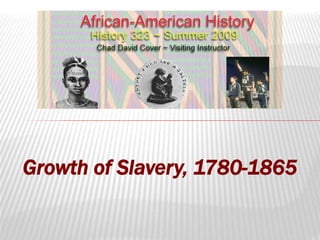African-American History ~ Growth of Slavery
- 1. Growth of Slavery, 1780-1865
- 3. U.S. Slave Population 698,000 894,000 1,191,000 1,538,000 2,009,000 2,487,000 3,204,000 3,954,000 1790 1800 1810 1820 1830 1840 1850 1860
- 4. Proportion of Slaves 1790 1800 1810 1820 1830 1840 1850 1860 8% 11% 14% 13% 14% 13% 12% 11% 92% 89% 86% 87% 86% 87% 88% 89% % Free % Enslaved
- 5. Where Did Slaves Live? Plantations of 1 - 9 Slaves 25% Plantations of 10 - 49 Slaves 50% Plantations of 50+ Slaves 25%
- 6. Who Owned Slaves? Slave Owners 36% Non- Slave Owners 64% Percentage of Southern Slave Owners, 1830 Slave Owners 26% Non- Slave Owners 74% Percentage of Southern Slave Owners, 1850
- 7. Profile of Slave Owners OWN 75% of slaves 25% of slaves 3% of slaveholders OWN Owners 1 - 49 Slaves Owners 50+ Slaves 97% of Slaveholders
- 8. Distribution of Slave Labor
- 10. Growth of Slave Population
- 12. Slave Auction
- 13. Slave Coffle
- 14. Domestic Slave Trade Routes
Editor's Notes
- #2: (copyleft 2007) Chad David Cover. Attribution-Noncommercial-Share Alike 1.0 Generic. See http://creativecommons.org/licenses/by-nc-sa/1.0/
- #3: Harper's Weekly (Dec. 18, 1869), p. 813. (Copy in Special Collections Department, University of Virginia Library) Comments Caption: "The First Cotton Gin". Shows two black men operating the gin, women carrying bales, children helping; also two white men. Illustration accompanies an article (p. 814) describing the construction of this gin, a model that preceded the one invented by Eli Whitney. A version of this image was later published in Charles C. Coffin, Building the Nation (New York, 1883), p. 76.
- #19: Territorial Accommodation Stronger Fugitive Slave Law Washington D.C. Slave Market shut down (although private sales remained legal, as did slavery)



















